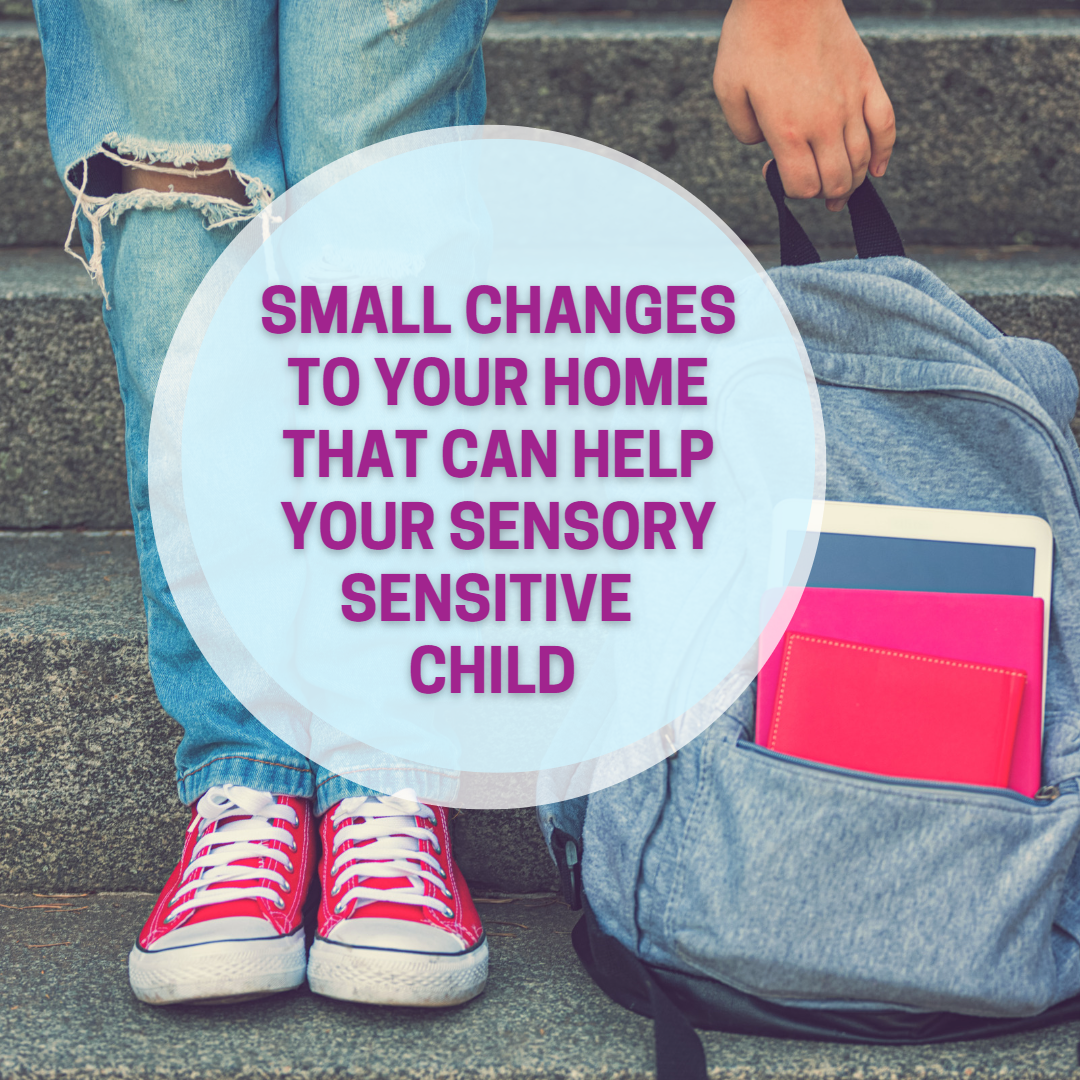Blog
Small Changes To Your Home That Can Help Your Sensory Sensitive Child

This post is all about Small Changes to your home that can help your sensory sensitive child. These are quick sensory adaptation tips to make life easier for your sensory child.
In this post and the next you’ll find 121 quick and easy tips and strategies for small everyday adaptations to make your sensory child’s environment work for him.General adaptation tips
– Say no to overly bright situations– Say no to noisy situations
– Say no to smelly situations
– Say no to crowded situations
– Inspect surroundings from your child’s viewpoint so you can modify them
– Don’t worry about what other people are thinking; do what’s best for your child
Visual (sight) adaptation tips
– Choose lighting that is as close to natural light as possible– Incandescent or “warm white” bulbs are the closest
– Use lamp lighting where possible
– Install dimmable lights to make it easier to control the level of light
– Avoid lights that flicker, such as fluorescents
– If you must have fluorescent lights, put ceiling covers over them
– Reduce glare from outside by tinting the windows or adding an anti-glare coating
– Have your child wear sunglasses, even inside, if lighting is too bright
– In bright outdoor lighting, offer your child sunglasses, a cap, or visor
– Don’t paint walls or large pieces of furniture in bright, bold colors
– Paint walls pale pastel colors or “cool” calming colors such as blue or green
– Use a monochromatic color scheme
– Clean up the clutter
– Put toys and other loose objects into bins
– Bookcases with storage containers create a neat, organized storage system
– Keep cabinet and closet doors closed
– Use an open design for your space, if possible
– Avoid cluttering the space with a lot of furniture
– Organize your home to make routines easier
– To block visual distractions when studying, you can surround your child’s workspace with a 3-sided poster board as a ‘study carrel’
– Try a lava lamp
– Try an aquarium or table fountain
Auditory (hearing) adaptation tips
– Don’t seat your child near a noisy air conditioner– Don’t seat your child near a dripping sink
– Don’t seat your child near a humming, clanking refrigerator
– Don’t seat your child near a loud dishwasher
– Don’t seat your child near a bathroom
– Don’t seat your child near a highly-trafficked area
– Turn off the tv
– Turn off the radio
– Turn down the volume of music
– Give your child earplugs, or noise-reducing or noise-canceling headphones in loud places
– Give your child an iPod with her favorite music
– Try rhythmic music
– Try drumming
– Try classical music
– Play nature sounds
– Play white noise
– Run a fan
– Don’t yell
– Use your “inside voice”
– Only one person should talk at a time
– Speak in short sentences
– Speak in a gentle tone
– Don’t slam doors
– Replace hard flooring with noise-dampening carpeting
– If you prefer hard flooring, use rugs to dampen sounds
– Use thick, high-quality carpet pads
– Add soft textures to the floor and walls to reduce echo in large open spaces
– Insulated or thicker-glass windows are good at blocking outdoor noise
– Install sound-absorbing insulation or an extra layer of drywall to block outdoor sounds
– Put toilet paper in the bowl to absorb sound before your child uses it
Olfactory (smell) adaptation tips
– Avoid strong odors in general– No scented markers
– No toys with strong smells
– No perfumes/colognes
– No strong-scented laundry detergents, fabric softeners, or dryer sheets
– No strong-scented household cleaners or wipes
– No strong-scented soaps
– No strong-scented deodorants
– No strong- or chemical-scented air freshener sprays
– No chemical-scented plug-ins
– No potpourri
– If even mild scents bother your child, switch to unscented products
– Open windows for ventilation when cooking
– Don’t serve smelly foods (blue cheese, strong fish, etc.)
– Choose natural fibers instead of synthetic; they have fewer offensive odors
– Try aromatherapy, especially scents such as vanilla and lavender
– Try putting lavender oil or another calming essential oil in a diffuser
– Try scented candles with mild, pleasant fragrances (unlit unless closely supervised)
– Have your child carry a pocket-sized lotion to sniff or apply under his nostrils to mask an unpleasant smell
– Give your child a chapstick to sniff or apply under her nostrils
– Have your child carry a handkerchief infused with a pleasant smell
– Have your child chew flavored gum (especially mint)
– Avoid smokers (cigarette, cigar, pipe, etc.)
I hope you enjoyed this post on Small Changes to your home that can help your sensory sensitive child.
Do you have additional tips that work for you and your sensory child? Please share your thoughts in the comments section below. Also, let me know there or via email what topics you would like to discuss or hear more about.
Feel free to share or quote from this blog (with attribution, please, and if possible, a link), and to repost on social media.
I look forward to hearing from you!
All the best,
Miriam
Don't want to miss a Thing?
Follow us on Instagram, Facebook, Youtube, and Pinterest to get updates and stay in the loop!
Other Post You May be Interested in:
